About 70% of all quadrocopters produced in the world are bought by Americans - every third US citizen has his own flying gadget. But over the past few years, a wave of interest in these drones has reached Russia. The situation on the market is similar to the global one - the positions of two giants, DJI and Parrot, can hardly be challenged.
But how to choose such a flying assistant, what to focus on, if you are attracted by Krakatau eruptions, sports broadcasts or just an interest in technical innovations? In the process of searching for an answer, several tablets, a plan and tips were born, which I share below.
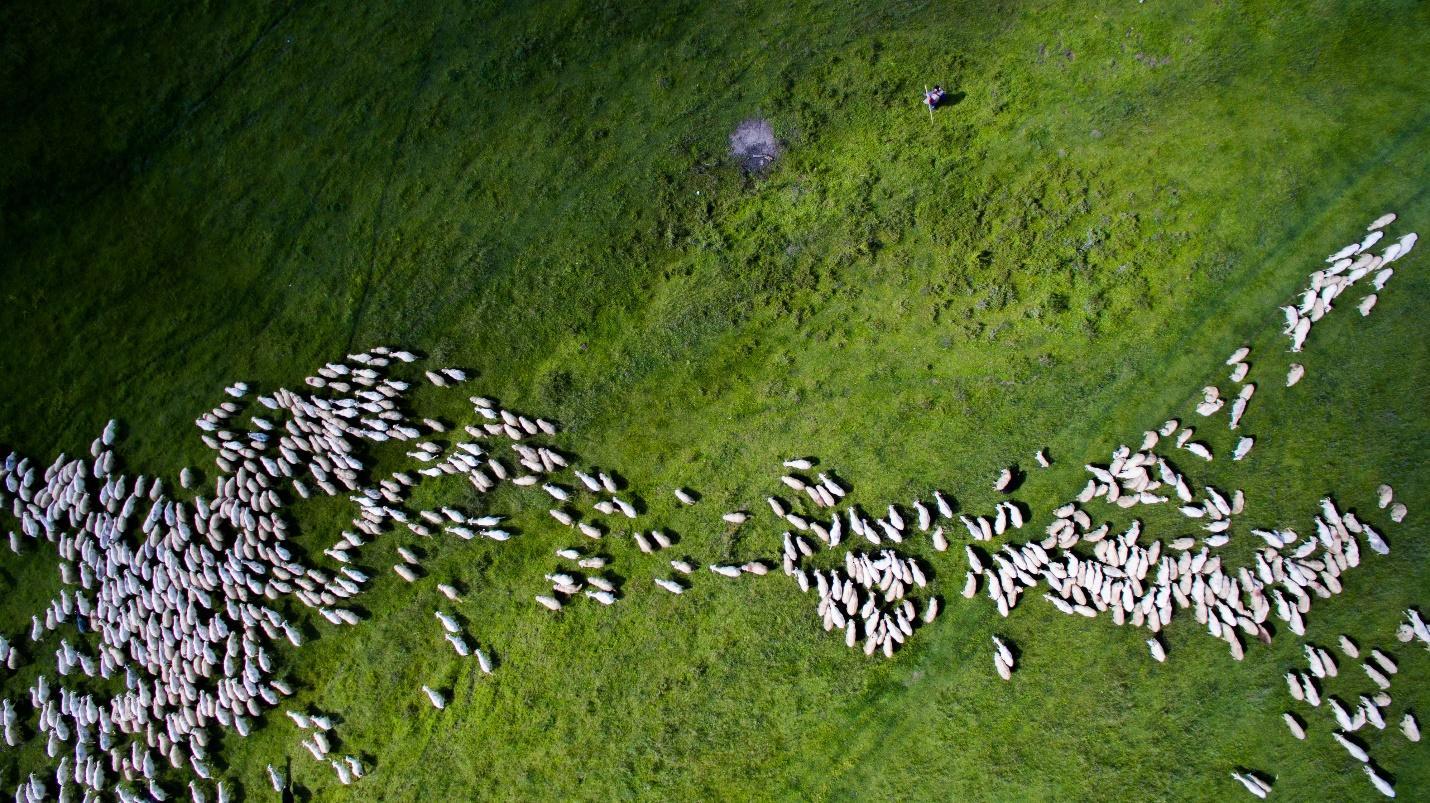
Terminology
Let's start, as usual, from the beginning. Quadcopters are UAVs (unmanned aerial vehicles) with four rotors. To compensate for the reactive moment, the two screws of the gadget, the front left and rear right, rotate in one direction, the front right and rear left in the other.
In technical literature, UAVs are often referred to as multicopters. Multicopters can be equipped not only with four, but also with two rotors (bicopter), three with tricopter, six with hexacopter, eight with octocopter.
Quadcopter manufacturers call them drones. However, it should be borne in mind that drones are the common name for all UAVs, including cars. Thus, it is allowed to call quadrocopters as UAVs, and drones or multikopter.
Types of quadcopters
By appointment quadrocopters are divided into professional and amateur. This classification is rather arbitrary, since the technical characteristics of many amateur models are very close to the parameters of professional ones, and with the advent of new models, the boundaries are increasingly blurred.
Quadcopter size is usually determined by the length of the frame diagonal. There are
three groups of gadgets :
- mini-quadcopters - the length of the diagonal does not exceed 25 cm. In this class the subgroup of micromodels is allocated - with a diagonal size of 5–7 cm;
- middle quadcopters - diagonal length 30–70 cm;
- large models - with a diagonal length of more than 70 cm.
Mini quadrocopters are mostly toy. The weight of most of them is less than 100 g. A gadget with such a mass is simply blown away by the wind, so microdrones are designed for flying only indoors. As a rule, children use them as a toy, and adults as a model for training before buying more serious samples. Parrot reigns supreme in this market.
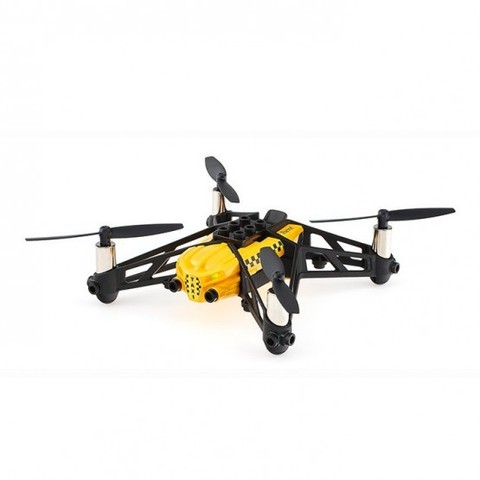 Minidron Parrot Airborne CargoLight thin minidrony
Minidron Parrot Airborne CargoLight thin minidrony with a diagonal length of 10 - 25 cm can fly in the open air only in calm weather. Sometimes the length of a quadrocopter diagonal weighing 200–300 g can exceed 25 cm, but with a low power of the motor such models are still referred to as mini-tons.
Average quadcopters are used for sports or amateur filming. Medium and large drones are equipped with professional equipment for aerial photography. The quality of the image obtained with the help of large and medium quadcopters depends not only on the technical characteristics of the camera, but also on the stabilization system that prevents picture jitter.
The quality of the drone also depends on the
type of motor :
- toy models are equipped with collector motors;
- for medium and large quadcopters designed for flying in the open air, install more durable brushless motors.

Parrot and DJI
It is interesting to consider the quadcopter production approach using the example of two market leaders: the Chinese company DJI Technology (Dajiang Innovation Technology) and the French Parrot SA.
DJI Technology was founded in 2006 by a Hong Kong entrepreneur (then still a student), Frank Wang Tao. In order to start production, one of Wan Tao’s companions had to sell his own apartment.
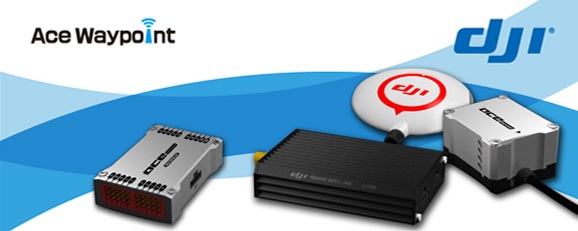 XP3.1 WayPoint - the first serial controllers to ensure the flight of DJI drones on a given route
XP3.1 WayPoint - the first serial controllers to ensure the flight of DJI drones on a given routeThe first DJI drones were incredibly expensive: the price of a UAV launched in 2010 was $ 10,000. It is clear that such a miracle gadget could not be in great demand. And then the company took the path of cheaper products due to the introduction of new technologies. The strategy came true: in 2014, 140,000 drones were sold. Today, DJI occupies 70% of the global drones market.
The French company Parrot was founded in 1994 by three companions: Christine de Tourvel, Jean-Pierre Talvard and Henri Seydoux. From the outset, the company specialized in the manufacture of wireless devices, the development of signal processing technologies and voice recognition. Since 2000, Parrot, together with the company Ericsson, has taken up the introduction of the Bluetooth Hands Free technology. From here to the production of drones - just one step.
In 2010, Parrot introduced its first UAV Parrot AR.Drone. Due to the combination of affordable prices and high quality, it was such a stunning success that in 2015 the company created a subsidiary company Parrot Drones.
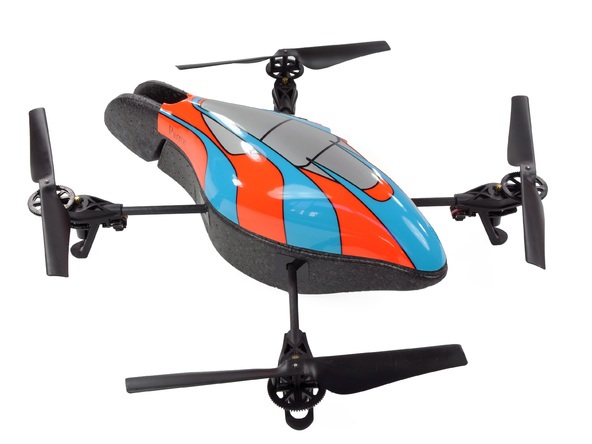 Parrot AR.Drone
Parrot AR.DroneDJI model overview
Journalists gave DJI the nickname "Apple among drones." This analogy is fully connected with the high quality and durability of quadrocopters, as well as with the wide use of new materials and the development of technologies.
From 2014 to 2016, the lines of professional DJI Phantom and Inspire models were unmatched. However, in September 2016, DJI introduced the
Mavic Pro model of the folding drone.
Table 1. Comparison of characteristics of the Phantom lines (for example, Phantom 4 ), Inspire ( Inspire 2 ) and Mavic ( Mavic Pro Combo )
All DJI models are equipped with GPS and Glonass sensors, support TapFly (flying to a point specified by the operator) and ActiveTrack (following the object) intelligent modes. Inspire 2 quadcopter is recommended to be operated at temperatures from -20 to +40 ° C, Phantom 4 and Mavic Pro - from 0 to +40 ° C.
Inspire 2 is a professional gadget with which you can make movies of a Hollywood class. The body of the device is made of light and very durable aluminum-magnesium alloy. To get high-quality video, two operators must manage the drone, each from its own remote control: one responsible for the flight (it receives data from the front camera), the other for the main camera. The main camera (user selectable - Zenmuse X4S or X5S) rotates 360 °. To prevent the chassis from entering the frame, they are automatically retracted in flight. The data transmission range is up to 7 km. Using Inspire 2, journalists can directly broadcast from the scene.
DJI Inspire 2Phantom 4 - drone with excellent aerodynamic properties. It is very stable in the air, and thanks to the three-axis stabilization system, the picture does not tremble even with abrupt changes in course. The viewing angle of the camera lens is 94 °, there are almost no geometric distortions. Lightbridge 2 technology is used to transfer data - the same as in Inspire 2. But managing Phantom 4 is very simple, one operator can handle it.
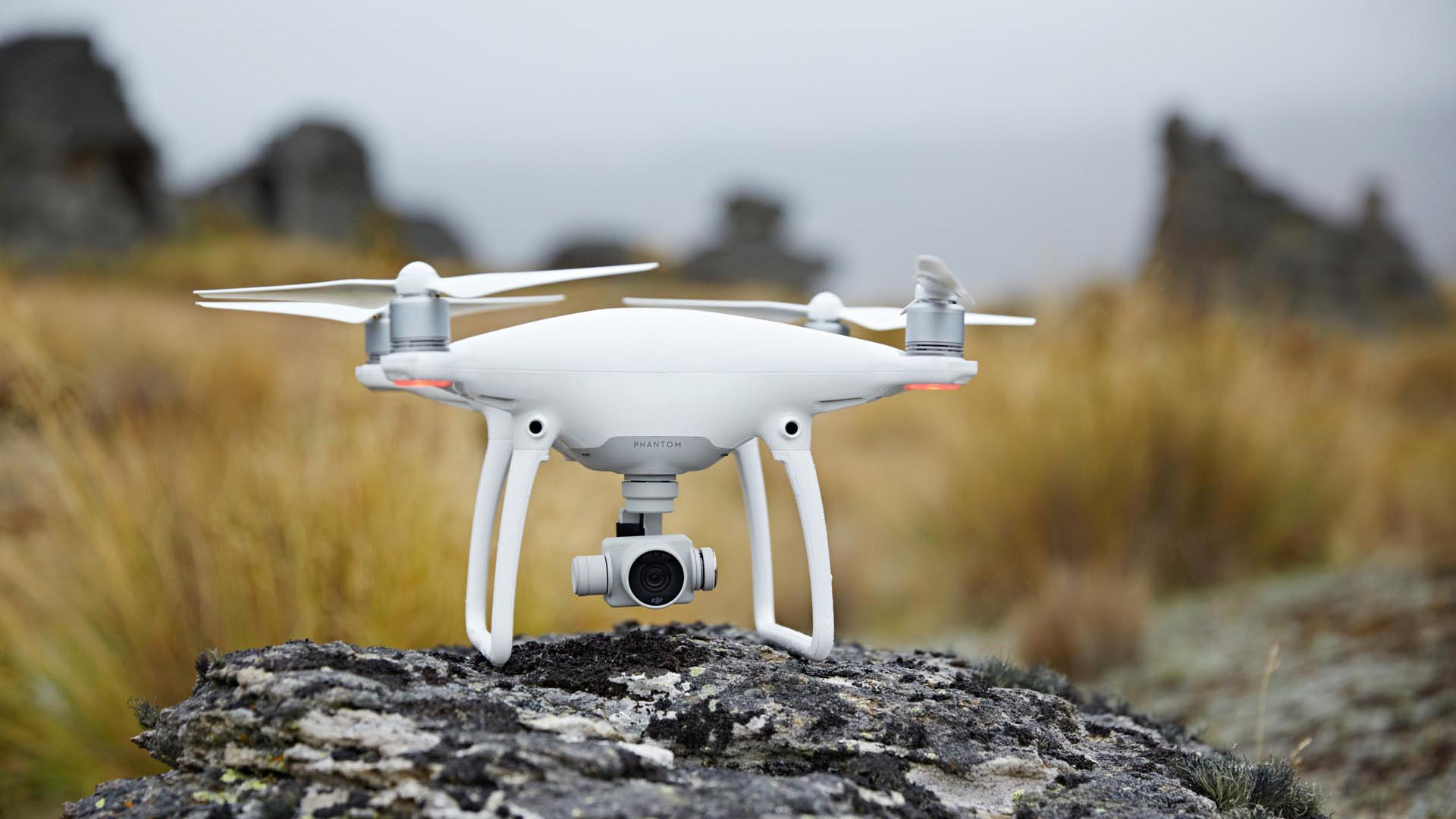 DJI Phantom 4Mavic Pro is
DJI Phantom 4Mavic Pro is indispensable for tourists and lovers of extreme sports. The Phantom 4 and the diagonal of the decomposed Mavic Pro are about the same. But if for carrying the Phantom 4 you definitely need a special box, then the lightweight folding Mavic Pro in a durable "non-killing" case can be carried in a backpack or large pocket. In order not to damage the lens, it is covered with a special cap. At the same time, the technical characteristics of the Mavic Pro camera are impressive. True, the viewing angle of the lens is only 78.8 °. But the image is not distorted, even if the camera is located close to the object.
In the air, Mavic Pro, despite its low weight, is very stable, the three-axis stabilization system compensates for vibration due to gusts of wind, so the image does not tremble. When transferring data is used not only Wi-Fi, but also the latest technology Ocusync, the range is up to 7 km. High-quality video can be immediately broadcast to social networks.
Despite the fact that the Mavic Pro remote is miniaturized, the designers made it possible to operate the gadget simply from a smartphone or even with gestures.
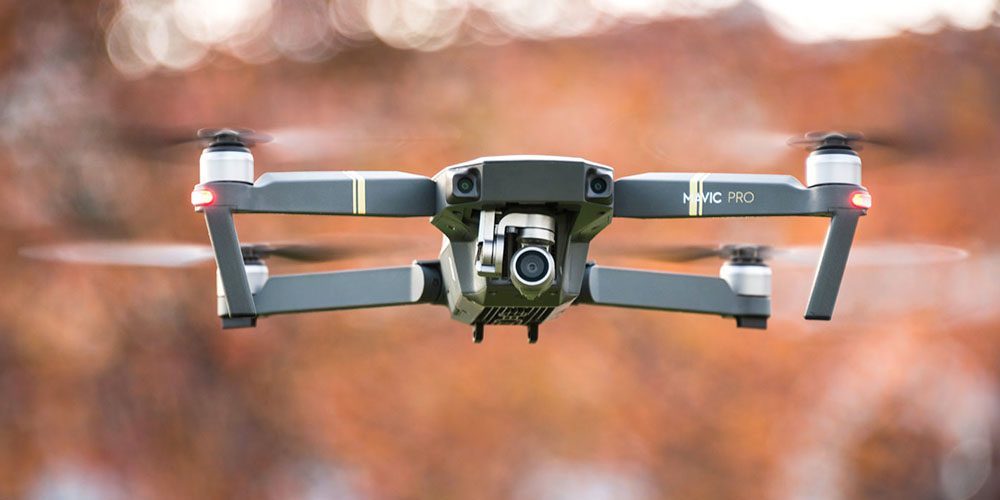 DJI Mavic Pro
DJI Mavic ProA week ago, a new and most (so far) compact model of the company -
DJI Spark . The model weighs 300 g, the diagonal is 6 cm smaller than that of the Mavic Pro, the functionality is slightly simplified for the sake of reducing the size. For example, the viewing angle of the image can only be changed up and down, and to rotate the camera to the side you will have to turn the quadcopter itself. The drone accelerates to 50 km / h in sport mode, but the battery life is modest - only 16 minutes from one charge at a speed of 20 km / h. This disadvantage is compensated by the ability to charge the drone from a portable power bank or any other power source via a USB cable. Like its predecessor, Spark is able to perceive commands with gestures. The camera is equipped with a CMOS sensor 1 / 2.3 inches. The resolution of photos taken with the help of the novelty will be 12 megapixels, and Full HD video can be shot at a frequency of 30 frames per second. To remove a panorama, it will be enough to press one button.
For the safety of the drone system is responsible of sensors and sensors, which prevents the fall or collision with other objects. To control the map with an accuracy of up to 30 m, GPS and GLONASS navigation systems are used. At loss of a signal the quadcopter will return back. There are no models officially imported into Russia yet, so you can only get the model by preorder.
 DJI Spark
DJI SparkParrot model overview
The Parrot company logo is a funny parrot. "Parrot" colors: red, yellow and green - are often used in the design of the company's gadgets. The company's products are designed for a wide range of consumers.
It is supposed that a teenager who has played enough with Parrot mini-guns will keep the best memories of them and, having matured, will buy a multifunctional quadcopter
AR.Drone ,
Bebop 2 FPV or
Disco FPV .
Parrot toy quadcopters with multi-colored stickers and LED-backlit in appearance resemble alien dragonflies. They are very fast and maneuverable.
Parrot airborne nightTable 2. Comparison of the characteristics of Parrot minidrons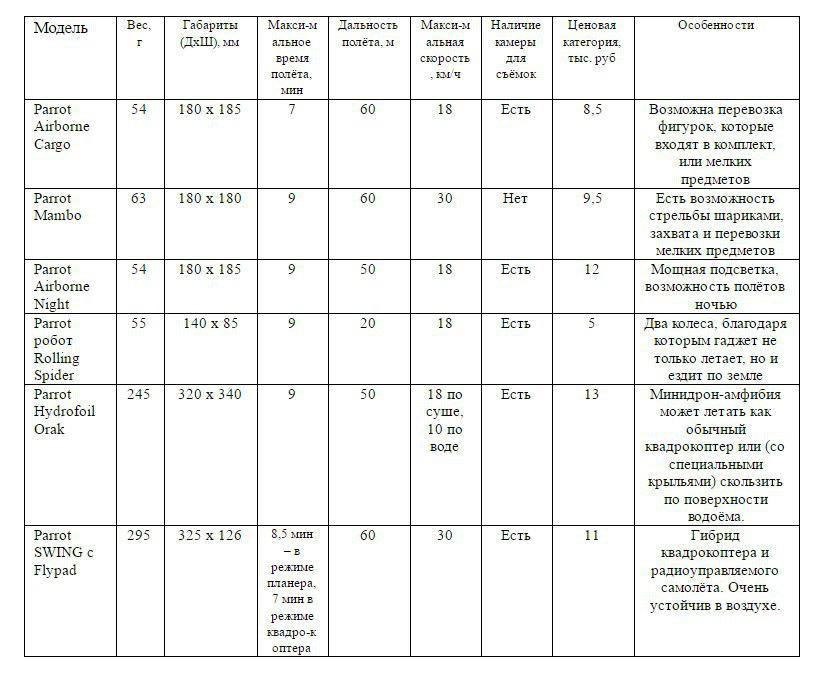
For those who are already fed up with mini-quadcopters and want to get a gadget more serious, the company Parrot offers more complex, multifunctional models.
Table 3. Comparison of the characteristics of Parrot multifunctional drones 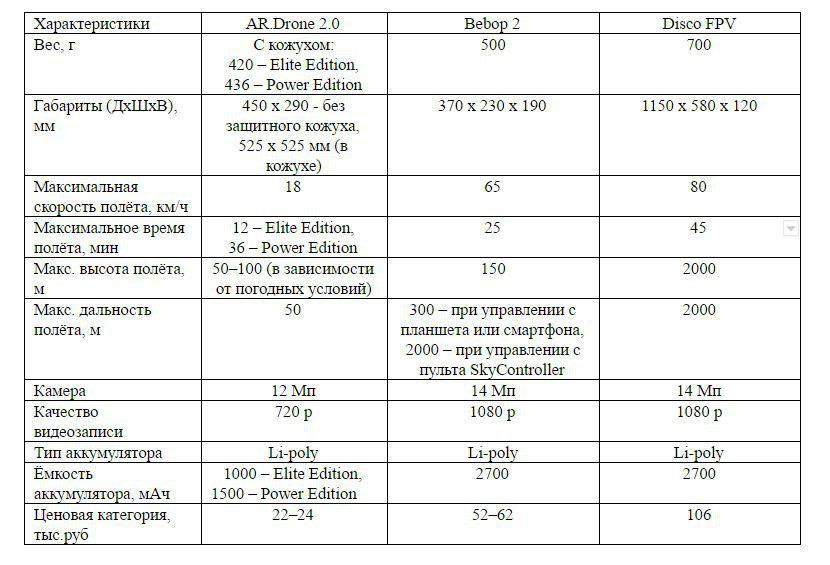
Optimal conditions for flying Parrot drones - temperature from 0 to 40 ° C.
Parrot AR.Drone 2.0 - one of the most popular amateur quadcopters. In terms of price and performance it suits both experienced users and beginners. With it, it is very convenient to master the technique of flying at home and on the street: thanks to the protective casing, the quadrocopter does not damage the furnishings. Although the casing is considered a “home” accessory, for greater safety, it is recommended to wear it when flying in the open air, especially in the city. The range and altitude of the gadget are limited to the range of the reception signal Wi-Fi. If the user wants his “bird” to fly farther and higher, you can additionally purchase a signal amplifier. But it is not recommended to “overthrow” too much, as the body is fragile and not capable of withstanding collisions with all obstacles. Manufacturers made sure that the user was comfortable to take the gadget on a trip: the charger is equipped with 4 plugs designed for different types of sockets.
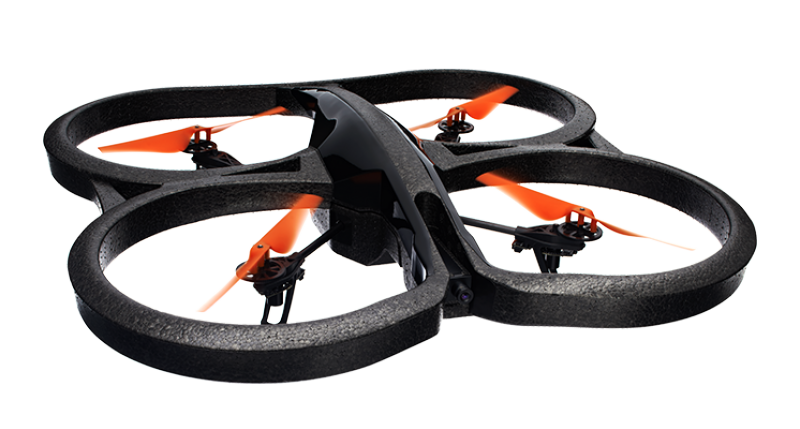 Parrot AR.Drone 2.0Parrot Bebop 2
Parrot AR.Drone 2.0Parrot Bebop 2 could compete with the DJI Mavic Pro, if not for the flight distance - just 2 km. However, the indisputable plus of the Parrot Bebop 2 is the speed of 65 km / h and high maneuverability. When tested in a wind tunnel, the unit was able to withstand a headwind with a speed of up to 65 km / h at a distance of 300 m. Thanks to a well-designed video stabilization system, it turns out very high quality, the picture is not trembling.
Parrot bebop 2Model
Parrot Disco FPV designers gave shape to the aircraft, which significantly improved its aerodynamic qualities. For technical specifications, this gadget is a competitor to the Phantom 4. A small flight range (2 km) is compensated for by high speed and maneuverability. Thanks to the stabilization system, the image does not tremble. Video quality 1080 p Full HD is transmitted to the smartphone in real time.
Parrot Disco FVPTips for choosing a quadrocopter
A seller who buys a quadrocopter for the first time can be puzzled by the seller: RTF or KIT? RTF (Ready-to-Fly) - this, in fact, is a quadrocopter: branded, factory assembly. In order for it to fly, it just needs to be taken out of the box (it is possible to put on screws) and charge. KIT is the “constructor” from which you need to assemble a drone. It is clear that the assembly requires a certain level of knowledge and experience, as well as time.
There are several universal recommendations that will suit both beginners and more experienced users:
- Decide on the amount you are willing to spend on the purchase of a drone.
- Beginners for training too expensive models do not make sense. Too small gadgets are not suitable either: they are not very convenient to manage. It is better to buy an inexpensive light toy with a diagonal of 20-25 cm. Parrot mini-gunns are ideal here: thanks to the backlight, you can clearly see where they have the front compartment.
- Choosing a quadcopter, you should think about what will happen if it falls. The most durable enclosures are made of carbon and aluminum alloys. It is desirable that the screws are protected.
- The most durable motors are brushless.
- If you do not plan on taking pictures of a volcanic eruption or the summit of Everest, but are going to limit yourself to a nearby park, then you may well save by buying a gadget with a smaller radius of action, but a good video camera.
- If you need very high image quality, and the budget is limited, it is advisable to buy a quadrocopter with a reliable stabilization system, and to purchase a GoPro camera separately.
- When buying an expensive quadcopter, be sure to get special glasses . Wearing them, you will see the world from a bird's flight.
Results
So, what are the results of our battle of the titans? In appearance they should not be compared, it is too individual. It is worth noting that the color diversity of Parrot is bigger.
The main criteria for selection are work time, lift height, quality of shooting. Recently, it is possible to charge a drone from USB (as in the new Spark). Determine for yourself what quality of photos and videos you need - if you are determined by specific pixel characteristics or ISO, then you are at the DJI counter. If you simply good quality, then it makes no sense to overpay.
Evaluate whether you have to shoot at high negative temperatures - if so, the Parrot models will not suit you, they are not intended for conditions below zero.
It may be worth starting from the budget - if it is acceptable for you to spend the amount needed to purchase the same Mavic Pro, then there is no point in comparing it with the Parrot line. On the other hand, if you just need a stable device that performs its functions with high quality - we are sure that Parrot Bebop 2 will please you.
Not that friendship won ... Just the contestants were from different categories. DJI - professional, Parrot - family amateur.

If suddenly you liked any of the drones - welcome to the website
Inspector Gadgets ! Undecided ready to help with advice.
Write in the comments which quadrocopter you liked the most and why - it’s interesting to know your opinion!